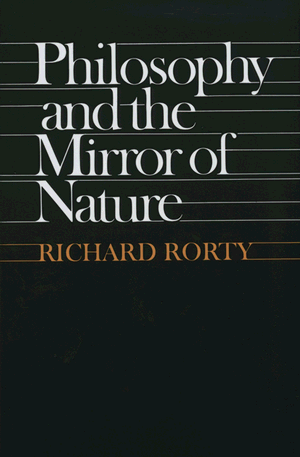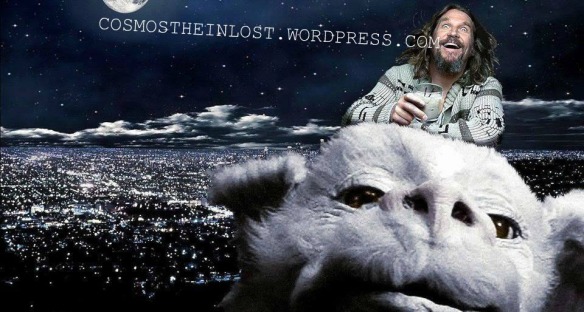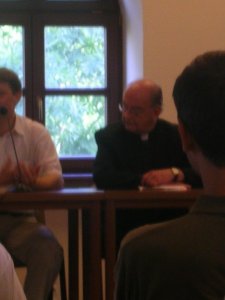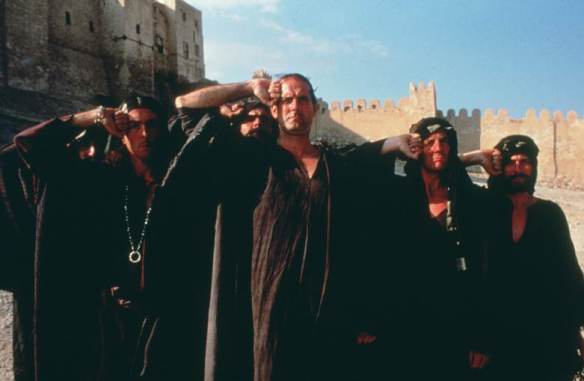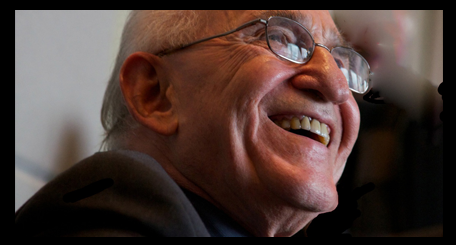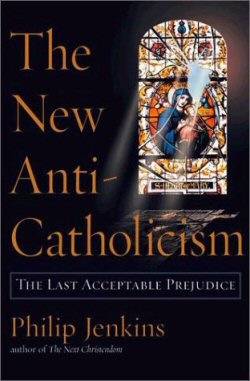
But don’t they have it coming to them?
[The contents of this post have been slightly modified for this repost.]
Systematic prejudice in America is rightfully in the spotlight again after yesterday’s verdict in Florida. The reaction to it reminded me of an article by Philip Jenkins, a sociologist who is America’s most even-handed commentator on religion. The article below summarizes the argument of one of his most important books The New Anti-Catholicism: The Last Acceptable Prejudice.
The irony is that anti-Catholicism is so pervasive in the United States that it’s invisible. The biased coverage of the priest sex-abuse scandals is one recent example that’s also the subject of another book by Jenkins, Priests and Pedophiles.
I also dug out this article because of a bigoted anti-Catholic comment today on my Kristeva post by someone named “Frank.” I initially wanted to respond to it, but the whole thread landed in this blog’s trashcan. I realized something on the level of Chick Tracts and Maria Monk doesn’t dignify a reply.

Good riddance. [Photo: St. James Cathedral Vandalized]
The whole episode also reminded me that Seattle’s St. James Cathedral was recently defaced by graffiti and that my own parish, Blessed Sacrament, is presently subject to various threats by a vandal. I don’t usually think of these things too often, because they don’t seem unusual. It’s also yet another reason why the bishops should be more reserved about clothing their arguments in American rhetoric and imagery.
It’s been pointed out by Justin Tse of Religion Ethnicity Wired that the argument Jenkins advances might suffer from some of the same nationalist shortcomings that plagued the Fortnight Campaign. This is because Jenkins seems to propose that Catholics should borrow strategies from other American victim groups and work within the American system instead of distancing themselves from it. You decide!
===========
The following article initially appeared in the May 2003 issue of Catalyst Magazine.
“Catholic-Bashing: America’s Last Acceptable Prejudice”
U.S. groups that are scrupulously PC about offending religious institutions make one major exception: the Roman Catholic Church.
BY: Philip Jenkins
For readers of Catalyst, expressions of anti-Catholic bigotry scarcely come as a surprise. Over the years, we have come to expect that media treatments of the Church, its clergy and its faithful will be negative, if not highly offensive, and Catholic organizations try to confront the worst manifestations of prejudice. When such controversies erupt, the defenders of the various shows or productions commonly invoke a free speech defense. These productions are just legitimate commentary, we hear, so offended Catholics should just lighten up, and learn not to be hyper-sensitive. Sometimes, defenders just deny that the allegedly anti-Catholic works are anything like as hostile as they initially seem to be. All these arguments, though, miss one central point, namely that similarly controversial attacks would be tolerated against literally no other group, whether that group is religious, political or ethnic.
The issue should not be whether film X or art exhibit Y is deliberately intending to affront Catholics. We should rather ask whether comparable expressions would be allowed if they caused outrage or offense to any other group, whether or not that degree of offense seems reasonable or understandable to outsiders. If the answer is yes, that our society will indeed tolerate controversial or offensive presentations of other groups-of Muslims and Jews, African-Americans and Latinos, Asian-Americans and Native Americans, gays and lesbians- then Catholics should not protest that they are being singled out for unfair treatment. If, however, controversy is out of bounds for these other groups-as it assuredly is-then we certainly should not lighten up, and the Catholic League is going to be in business for a very long time to come.
It is easy to illustrate the degree of public sensitivity to images or displays that affect other social or religious groups-but how many of us realize how far the law has gone in accommodating the presumed privilege against offense? Witness the legal attempts over the last two decades to regulate so-called “hate speech.” American courts have never accepted that speech should be wholly unrestricted, but since the 1980s, a variety of activists have pressed for expanded laws or codes that would limit or suppress speech directed against particular groups, against women, racial minorities and homosexuals. The most ambitious of these speech codes were implemented on college campuses. Though many such codes have been struck down by the courts, a substantial section of liberal opinion believes that stringent laws should restrict the right to criticize minorities and other interest groups.
But if these provisions had been upheld in the courts, what would they have meant for recent Catholic controversies? One typical university code defines hate speech “as any verbal speech, harassment, and/or printed statements which can provoke mental and/or emotional anguish for any member of the University community.” Nothing in the code demands evidence that the offended person is a normal, average character not over-sensitive to insult. According to the speech codes, the fact of “causing anguish” is sufficient. Since the various codes placed so much emphasis on the likelihood of causing offense, rather than the intent of the act or speech involved, the codes might well have criminalized art exhibits like, oh, just to take a fantastic example, a photograph of a crucifix submerged in a jar of urine.

Above all, Piss Christ is crappy art.
The element of “causing offense” is central to speech codes. At the University of Michigan a proposed code would have prohibited “any behavior, verbal or physical, that stigmatizes or victimizes an individual on the basis of race, ethnicity, religion, sex, sexual orientation, creed, national origin, ancestry, age, marital status, handicap, or Vietnam-era veteran status.” “Stigmatization and victimization” are defined entirely by the subjective feelings of the groups who felt threatened. In 1992, the US Supreme Court upheld a local statute that prohibited the display of a symbol that one knows or has reason to know “arouses anger, alarm or resentment in others on the basis of race, color, creed, religion or gender.” The implied reference is to a swastika or a burning cross, but as it is written, the criterion is that the symbol causes “anger, alarm or resentment” to some unspecified person. These were precisely the reactions of many Catholic believers who saw or read about the “Piss Christ” photograph, or the controversial displays at the Brooklyn Museum of Art.
Other recent laws have taken full account of religious sensibilities, at least where non-Catholics are concerned. Take for instance the treatment of Native American religions, and the presentation of displays that (rightly) outrage Native peoples. In years gone by, museums nonchalantly displayed Indian skeletons in a way that would be unconscionable for any community, but which was all the more offensive for Native peoples, with their keen sensitivity to the treatment of the dead. In 1990, Congress passed NAGPRA, the Native American Graves Protection and Repatriation Act, which revolutionized the operation of American museums and galleries by requiring that all Indian remains and cultural artifacts should be repatriated to their tribal owners. As a matter of federal criminal law, NAGPRA established the principle that artistic and historical interests must be subordinate to the religious and cultural sensibilities of minority communities.
Even so, museums and cultural institutions have gone far beyond the letter of this strict law. They have systematically withdrawn or destroyed displays that might cause the slightest offense to Indian peoples, including such once-familiar displays as photographs of skeletons or grave-goods. In South-Western museums today, one commonly sees such images replaced with apologetic signs, which explain gaps in the exhibits in terms of new cultural sensitivities. Usually, museums state simply that the authorities of a given tribe have objected to an exhibit because it considers it hurtful or embarrassing, without even giving the grounds for this opinion, yet that is enough to warrant removal. When disputes arise, the viewpoint of the minority group must be treated as authoritative. Just imagine an even milder version of this legal principle being applied to starkly offensive images like those at the Brooklyn Museum of Art. If Native religion deserves respect and restraint on the part of commentators-as it assuredly does-why doesn’t Catholicism merit similar safeguards?
Beyond the legal realm, time and again we see that media outlets exercise a powerful self-censorship that suppresses controversial or offensive images, whether or not that “offense” is intended: and again, this restraint applies to every group, except Catholics. Over the years, the film industry has learned to suppress images or themes that affect an ever-growing number of protected categories. The caution about African-Americans is understandable, given the racist horrors in films of bygone years, but the present degree of sensitivity is astounding. Recall last year’s film “Barbershop,” in which Black characters exchange disrespectful remarks about such heroic figures as Rosa Parks and Martin Luther King, and more questionable characters like O. J. Simpson and Jesse Jackson. Though this was clearly not a racist attack, the outcry was ferocious: some things simply cannot be said in public. Jesse Jackson and Al Sharpton led an intense campaign to delete these touchy references.
And other social groups have learned these lessons about self-censorship. Asian-Americans and Latinos have both made it clear that the once-familiar stereotypes will no longer be tolerated, and Hollywood takes their complaints to heart. By the early 1990s, too, gay groups had achieved a similar immunity. When, in 1998, the film “The Siege” offered a (prescient) view of New York City under assault by Arab terrorists, the producers thought it politic to work closely with Arab-American and Muslim groups in order to minimize charges of stereotyping and negative portrayals. Activists thought that any film depicting how “Arab terrorists methodically lay waste to Manhattan” was not only clearly fantastic in its own right, but also “reinforces historically damaging stereotypes.” As everyone knew, Hollywood had a public responsibility not to encourage such labeling.
Yet no such qualms affect the making of films or television series that might offend America’s sixty million Catholics. Any suggestion that the makers of such films should consult with Catholic authorities or interest groups would be dismissed as promoting censorship, and a grossly inappropriate religious interference with artistic self-expression. The fuss over whether a film like “Dogma” or “Stigmata” is intentionally anti-Catholic misses the point. The question is not why American studios release films that will annoy and offend Catholics, but why they do not more regularly deal with subject matter that would be equally uncomfortable or objectionable to other traditions or interest groups. If they did so, American films might be much more interesting, in addition to demonstrating a new consistency.
If works of art are to offend, they should do so on an equal opportunity basis. If we have to tolerate such atrocities as “Sister Mary Ignatius Explains It All For You”-recently revived as a Showtime special-then why should we not have merry satires poking fun at secular icons like Matthew Shepard or Martin Luther King? If, on the other hand, it is ugly and unacceptable even to contemplate an imaginary production of “Matthew Explains It All,” poking fun at victims of gay-bashing, then why should we put up with Sister Mary? Some consistency, please.
Let me end with a suggestion. By all means, let the Catholic League continue to report offensive depictions of Catholics and their church. But to put these in perspective, always remember to record these many other controversies, in which other groups succeed in enforcing their right to be free from offense. Only then can Catholic-bashing be seen for what it is, America’s last acceptable prejudice.
